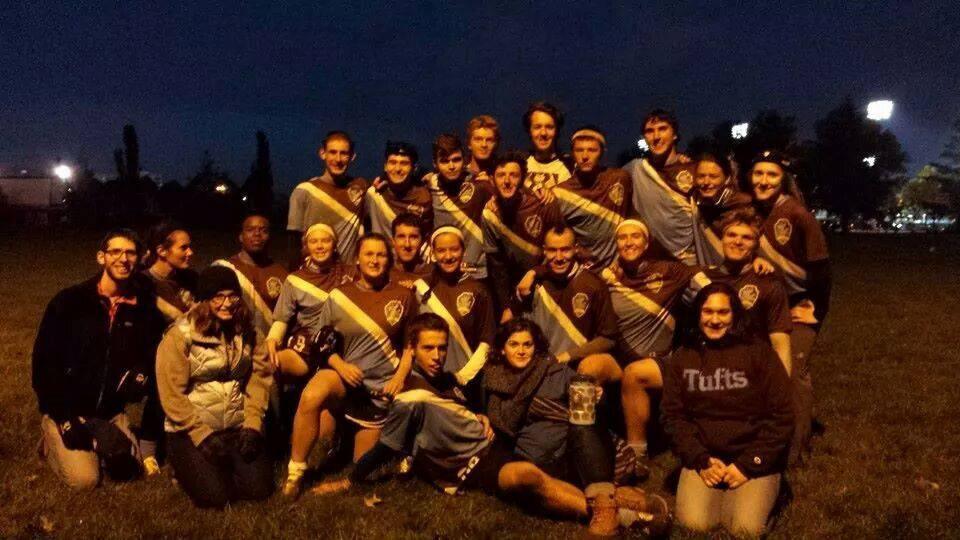- Rule, Britannia, no more?
- Unpopular Opinions: US Quadball Cup 2023
- Proven Contenders: University of Virginia
- Proven Contenders: Rutgers University
- Proven Contenders: University of Michigan
- Proven Contenders: Creighton University
- Different Perspectives: A Look Inside USA Ultimate
- Antwerp QC, Much of Belgian Core, Leaves Competitive Quidditch
Weekly Water Cooler: Surprises, Upsets
- Updated: October 16, 2014
Seeing as this first 500 words of my column is my personal space and because it is my main means of public expression, I am going to abuse it a bit this week to talk about something that matters a lot to me. You are just going to have to bear with me (alternatively, you can just skip this section).
This weekend, Tufts University won a quidditch tournament.
Yes, I know, there are multiple quidditch tournaments every weekend for eight straight months and winning one, with maybe the exception of World Cup, is not the biggest deal in the world, but for this team, it is.
Tufts has never won a tournament before.
Tufts quidditch was founded almost exactly five years ago. It has competed in four World Cups and is one of only nine programs ever to have every played in a final. Next week will make a full year straight in which the team has been ranked in the top 20 of our poll. The team put multiple players onto Global Games teams over the summer. But a tournament victory? That has always eluded us.
In part, it is a matter of circumstance. Tufts is in a city with both Boston University and Emerson College, two historic powerhouses in quidditch that developed even further back than Tufts. Any time the team was close to grabbing a tournament, one of the two was there to shut them down. Even so, there have been close calls, including the World Cup final itself and last year’s Turtle Cup, where Tufts got past the NYDC Capitalists in a crazy semifinal game only to fall to, you guessed it, Emerson.
At the end of the 2012-13 season, the players that founded the team graduated without a tournament victory. A year later, a second generation did the same. Tufts was not making it any easier on itself, finishing the 2013-14 season with the highest strength of schedule of any team in the country outside of the Southwest’s Big Four.
But finally, this weekend, everything clicked. The weather let up just enough in the afternoon for actual quidditch to be played. The bracket broke in a friendly way, and before anyone knew it, the snitch was being released onto the finals pitch with Tufts out-of-range of University of Maryland.
There could not have been a more perfect time for it to happen.
Four of the original members of the team were on hand to watch, people who were responsible for the team even existing and who had never played with some of the current players. But when it came time to celebrate, players new and old embraced each other like family.
It was the perfect blending: the people that breathed life into the team and the people who have kept it going strong.
Thanks to all of them, Tufts can now say it has won a tournament.
Final Surprise
Let’s now touch on that Oktoberfest Invitational final and let’s not bury the lead: No. 11 Tufts beat No. 3 Maryland in the finals, 160*-70, becoming the first team to put the Terrapins out of snitch range going back at least as far as the 2012-13 season.
The question is, how do we go about reasoning out this result. We will start with the simple: Maryland was down numerous players, including two of its keepers in Matt Paesch and Josh Marks; its most physical beater in Ben Tunick; and one of its most talented utility players in Steve Gambino. Tufts, meanwhile, was more or less completely full strength, only missing keeper Steve Mullahoo, who had suffered a severe concussion earlier in the day.
On the field, Tufts chose strategically to fight Maryland on a different plane, coming out with a two-male beater set for the first 10 minutes to attempt to maintain an advantage in the bludger game to counter the depth and skill of the Terrapins chasers lines. The gambit paid off, as Tufts opened up an early lead that they never relinquished. Of course, a pair of double yellow cards on the Maryland side of the ball made that quite a bit easier.
The Tufts victory also was not an isolated incident in bracket play for Maryland. The Terrapins found themselves trailing New York University when they caught to salvage a 90*-70 victory and failed to get out of range against No. 5 QC Boston: the Massacre’s two male beater set as well, eventually winning 150*-90. While Maryland’s seeker game is part of what makes them so dominant, that is an awful lot of close results for a team that entered the weekend as one of the top three in the country.
The tournament really touched on the biggest issue Maryland will face going forward: the lack of an elite beating game. As has been touched on before, the Terrapins bleed bludger control, and if the opposition can make that count, it can be hard for Maryland to pull away. Still, I expect Maryland to make the adjustments both in how protective they are with control and how they defend against 1.5 bludgers sooner rather than later—something starting beater Jeremy Dehn has really struggled with early this season—and through that, there will be fewer and fewer ways to get an advantage over them.
When it comes down to it, Maryland has the deepest, most physical chaser core outside of the Southwest, with an elite seeking game to boot, and that makes them still, by far, the most likely team from outside that region to make a deep World Cup run. But this weekend showed that the gap between them and the rest of the field was smaller than seemed, and the onus is now on the Terrapins to make the adjustments as we head into regional season.
On the Tufts side of the ball, we have a young team that is finally coming into its own. Emily Hickmott and Hannah DeBaets have both developed into complete, talented female chasers that allow Tufts to go to a two-male beater set whenever they want without skipping a beat. Matt Cardarelli has continued his strong play at beater from over the summer, and David Stack, combining a pretty mid-range game with sharp passing at keeper, is developing into the star this team has never really had.
Still, there are holes to be filled if Tufts hopes to continue to put together the type of results they showed they were capable of this weekend. They may now have the results of a top-10 team nationally, but they definitely do not hit like one, and, eventually, that is going to bite them in the ass. Beating Maryland required absolutely draining the tanks of every top player they had, bringing up definite questions about their depth against elite competition. There is no doubt that Tufts benefited from their run to the finals, which involved none of the other four ranked teams that attended the tournament.
When it comes down to it, while the finals was a marquee game, it was just one game. Maryland already beat Tufts earlier in the day—a 90*-60 victory in a mud pit that hindered both sides—and would almost definitely take more than half of the results if the two played 10 times. But the gap is small enough that Tufts is capable of reaching across and taking it, and that is exactly what they did.
Lonely Tournament for Lone Star
Last year, the now-No. 1 Lone Star Quidditch Club—while hanging around as the No. 2 team in the country for most of the season—won a grand total of one quidditch tournament. This year, a month into the season, they already have two.
The game’s premiere community team—and arguably its premiere team—thoroughly deserved its victory in a Diamond Cup field that was castrated in comparison to last year’s tournament. Not only did the Lost Boys fail to make a return trip, but No. 2 University of Texas and No. 5 Texas A&M did as well, leaving the viewing public low on storylines and high on blowouts. When it came down to it, Lone Star had to take care of business in just one game, their finals match up with No. 7 Texas State University. They did, 140*-80.
Despite the finals loss, the Bobcats might have been the team that took the most advantage from the weakened field, bulldozing their way to the finals without any team staying within 100 points of them besides Loyola University (NO), who needed a suicide grab to do so. In the semifinals, they handled No. 4 Baylor University in a close match, 120*-80, before falling to Lone Star in the finals in a snitch range game.
It is easy to look over this as being an accomplishment for Texas State, given their World Cup VII finals run, but it is important to remember that run was the exception, not the rule, for the team last season. Before keeping Texas in range in the finals in April, Texas State was a combined 0-6 with only one game within closer than 30 quaffle points against Baylor, Texas A&M, Texas and Lone Star. This year, they have now already recorded two snitch-range games and their first victory over the Southwest’s Big Four. With all of that in mind, it is hard to argue after this weekend’s results that Texas State is not a tier-one Southwest team.
Part of what is likely to make this a successful season for the Bobcats is just how much they returned. In a sport where turnover hits just about every team hard, Texas State is returning not just almost all of the names you recognize—quaffle stars Eric Reyes and Richard Kemp and top beater pair Ryan Peavler and Beth Clementi—but much of their depth as well. Texas State has been building on this core for multiple years now and finally seems prepared to reap the full benefits.
On the other end of the spectrum from Texas State and Lone Star’s performance was Clonestar Quidditch Club, Lone Star’s B-team. There was a lot of hype surrounding the team coming into the weekend, but suffice to say they did not live up to literally any of it, being outscored by just under 100 quaffle points per game in their four losses, which came to Texas State, Sam Houston State Unviersity and twice to Loyola.
Honestly, it isnot that surprising to see these kinds of results. With Lone Star barely capable of fielding a full team of female players, it is hard to imagine Clonestars having anything going for them in that department. And the Houston squad that makes up much of the Clonestars core was not all that impressive last season, especially without any contributions from either Dugie brother, with Hank Dugie playing for Lone Star and Justin Dugie in the service. Unless some drastic new recruiting pipeline appears, it could be a long year for one of the first-ever community B-teams.
New Tier of Team
In the past, putting quidditch teams in tiers has always been a fairly straightforward proposition. Each tier represents a skill level, and it was almost unheard of for teams from lower tiers to score even a single win over teams from high tiers.
But this season, I am noticing a shift in that dynamic. Now, there are the upper-tier teams with elite talent, but there are also lower-tier teams with a keen eye for strategy and making the most of what they have. With strategy and film in the sport both at all-time highs, those lower-tier teams are starting to be able to close the gap.
Obviously, it is hard to start this anywhere else but with No. 18 Ball State University, who is now making this column even on weeks they do not play. With graduation hitting the team hard in both talent and depth, the Cardinals made the adjustments to stay competitive, implementing a slow-paced, two-male-beater-heavy plan that has already scored them victories over No. 15 Bowling Green University, No. 8 Ohio State and No. 17 University of Michigan.
But they are not the only team looking for innovative new ways to win quidditch matches. This weekend, both NYU and Hofstra University showed the ability to play in ways that kept them competitive with the best teams on the east coast.
For NYU, that started and ended with star beater and captain Kyle Jeon. Jeon, through the team’s first two major tournaments, has thrown numerous different looks out defensively, from man to zone to two male beaters to turtled bludgers. The constant switches make scouting the team extremely difficult and getting comfortable offensively in a game even more so. It is no coincidence that NYU stayed within range of Tufts and outscored Maryland in quaffle points in the quarterfinals.
For Hofstra, staying competitive means building a strategy around the team’s best player, Jaime Colon. On offense, that means patiently waiting at midfield until his beaters can clear out the bludgers briefly, giving Colon enough time for his nearly unstoppable drives to the hoops. On defense, the team turtles its bludgers, knowing the value control gives them offensively. For their trouble, Hofstra earned a victory over No. 12 Emerson and an overtime match with Tufts.
Now that these lower-tier teams have started pulling out new and innovative ways to compete, the ball is in the top teams court, and they are going to have to adjust. If the elite teams in the sport cannot figure out a way to make their talent advantage count, we could be looking at far more competitive matches this season than we are used to.






One Comment